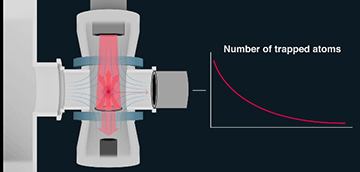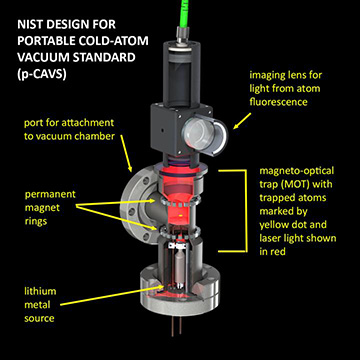
NIST scientists have designed an instrument that measures the strength of a vacuum by determining the rate of change of fluorescence of laser-trapped atoms within the vacuum, as background gas molecules in the vacuum kick the fluorescent atoms out of the trap. [Image: Sean Kelley/NIST]
Researchers at the U.S. National Institute of Standards and Technology (NIST) have designed a compact, drop-in instrument that would use ultracold laser-trapped atoms to measure extreme vacuum pressures (Metrologia, doi: 10.1088/1681-7575/aadbe4). The envisioned instrument—for which a prototype is still being built—makes clever use of a diffraction grating to convert a tabletop-sized measurement platform into a 20-cm-long device that can be deployed in existing vacuum chambers.
The “quantum SI” push
Several motivations have spurred the NIST group in its efforts to build a vacuum gauge based on a magneto-optical trap. One is the ongoing need for increasingly high levels of vacuum, both in established industrial settings such as semiconductor manufacture, where the drive to ever-finer tolerances is requiring ever-greater vacuum levels, and in emerging areas like quantum information science. Achieving and maintaining these exquisite vacuums demand ways to accurately measure them.
A deeper reason for the work, however, involves trends in metrology. Increasingly, as measurement techniques have grown ever more precise and sophisticated, the metrology community has converged on a drive to build a so-called “quantum SI”—an international effort to redefine the International System of Units (SI).
One element of the quantum-SI effort involves building devices that are “primary,” meaning that they provide measurements of a given, derived unit (in this case the pascal, the SI unit of pressure) in terms of seven other, fundamental SI units (such as the second, the kilogram and the kelvin). Those seven units, in turn, are based on fundamental constants and quantum phenomena, rather than on physical artifacts such as the notorious standard meter and standard kilogram.
The most common compact gauge for extreme vacuum, the Bayard–Alpert ionization gauge, is “non-primary,” according to the NIST researchers, and so is not compatible with the emerging quantum-SI standard. In particular, the ion gauge requires periodic recalibration against a physical standard, which sharpened NIST’s quest for a no-calibration-required “better mousetrap” for vacuum measurements.
Decaying fluorescence as a vacuum signal
The NIST team’s approach for measuring vacuum begins with the magento-optical trap itself. The trap consists of an array of six laser beams oriented in three orthogonal directions, and positioned within a magnetic field that varies from zero at the center of the trap to steadily increasing levels moving outward. Alkali-metal atoms, such as lithium, rubidium or cesium, are introduced into the trap and slowed and cooled by the laser light. The combined laser and magnetic fields also nudge the cold atoms to the center of the trap and hold them in place there.
NIST posted a video describing the principles of its trapped-atom vacuum sensors. [Credit: Sean Kelley/NIST]
Once in place, the metal atoms, under the influence of the lasers, begin to fluoresce, and the fluorescence signal is captured on a digital camera. When one of the sparsely distributed molecules of background gas in the vacuum chamber collides with a metal atom confined in the trap, the molecule kicks the atom out, which infinitesimally reduces the strength of the fluorescence signal. By measuring the rate of decay of the fluorescence signal over time, the researchers can get a precise measurement of the number of molecules bouncing around within the chamber—and, thus, of the level of vacuum.
From CAVS to p-CAVS
As part of its effort to define a primary standard for the pascal, NIST is already working to develop a lab-scale version of a trapped-atom vacuum gauge, the cold-atom vacuum standard (CAVS). The problem is that the CAVS is not exactly portable, residing on a two-meter-square optical table, and requiring multiple lasers firing from different directions. That’s fine for defining an international metrology standard—but not for building a deployable instrument that can plug into existing vacuum chambers to provide workaday measurements. (By way of comparison, the standard Bayard–Alpert ionization gauge used in many vacuum chambers requires only 30 cm3 of space.)
Shrinking the CAVS down to a deployable footprint is, according to the NIST authors, “an impressive challenge.” The team’s current design for meeting that challenge, the portable CAVS (p-CAVS), cleverly uses a combination of three micro-fabricated diffraction gratings to turn a single laser beam into six subsidiary beams that can be used in forming the optical part of the magneto-optical trap.
Design of the NIST p-CAVS portable vacuum sensor. [Image: Daniel Barker/NIST] [Enlarge image]
That design change radically reduces the optics needed to drive the system, and, in combination with other changes, shrinks the envisioned device to a mere 20 cm long. Another improvement in the NIST design is the use of lithium atoms, rather than the cesium or rubidium atoms more common in optical-trap applications. Among the advantages of lithium is a very low vapor pressure. That means that a vacuum chamber incorporating the p-CAVS can be “baked” at 150 °C to drive off water molecules without concern that lithium atoms will vaporize and contaminate the vacuum.
Prototype in the works
The NIST workers believe that the p-CAVS design promises a highly sensitive vacuum gauge that, because of its size, can be dropped into existing vacuum chambers. And the instrument, when realized, should meet the criteria of the quantum SI, requiring no calibration and founded only on fundamental constants and units (the kelvin and the second). That’s because the interaction dynamics between lithium and hydrogen (the principal gas that remains after the vacuum chamber has been baked and pumped to extreme-vacuum levels) can be calculated exactly from first principles.
Right now, the p-CAVS design is just that—a design. The NIST team is currently testing individual components of the device and working toward a prototype. “We are in the process of developing such a system that could potentially replace sensors now on the market,” team member Stephen Eckel said in a NIST press release, “as well as figuring out how to operate and evaluate it.”

